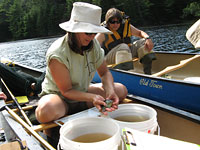

 | |||||||||||||
|
|
Journals 2009/2010Teresa Gable
August 20, 2009 Today, everyone joined forces for a large sampling project on Montsweag Brook. This is a freshwater brook that has a dam separating two sections. The section above the brook is more like a river and section below the dam is more like a brook. The purpose of this sampling event was to inventory what fish are present before the dam is eventually removed. An after study is planned to determine how the population of fish might change when/if the dam is removed. Everyone from the lab participated in this massive sampling effort. Representatives from Maine Department of Inland Fisheries & Wildlife (IFW), National Oceanographic & Atmospheric Administration (NOAA) and the Chewonki Foundations were also involved and working with us. Dr. Wilson and Dr. Willis are consulting with the Chewonki Foundation to help inventory the fish, benthic invertebrate and salt marsh species as part of a feasibility study before the dam removal. They are also helping to establish a sampling protocol so the students at the Chewonki Foundation can help to gather useful data that is uniform and reproducible. For the first half of the day I was with the IFW biologists and watched them electro-shocking fish. They had portable electro-shocking backpacks, which they wore on their backs. They wore rubber waders and gloves for safety. They walked in the stream and sent an electrical current in the water. We scooped up the fish with nets and placed them in a bucket. The idea was to collect all the fish possible and inventory them. Each fish was also measured for length and weight.
The most abundant species we found was the American eel, all different sizes. They were snake-like in their movement and they were the most difficult to handle. We also found pumpkinseed sunfish, juvenile largemouth bass, golden shiners and yellow perch. In the nets, we also caught three bullfrog tadpoles and a giant leech. They were placed back in the water immediately. After each fish was inventoried and measured, they were also released back into the brook. This took all morning. While we were working on this, a different crew was canoeing above the dam and setting two different types of nets in the water. The trammel nets were set up in two different locations to tangle and trap the larger fish. The green fyke net, which channels in the fish and holds them in a storage area, was also set in the water. The fyke net is a net that is more fish friendly then the trammel net.
Also, each net conducted a temperature/dissolved oxygen profile. This profile was used to determine how much oxygen is available to support the animals living in the water. It was discovered that the temperature of the water was warm and the dissolved oxygen was low in the deeper areas of the lake. In the afternoon, I worked on the water above the dam. We canoed out to the sites where the nets were anchored. We watched as the nets were pulled to the surface. The nets did their job and captured several fish including two big largemouth bass. The other fish caught included a white sucker, pumpkinseed sunfish, yellow perch, golden shiners and one chain pickerel. In the trammel nets, the fish we caught were larger in size and they got tangled in the net. Some of the fish died due to the poor environmental conditions and not being able to get enough oxygen through their gills even though the nets were only set for a few hours. We found several smaller fish in the fyke net. There were approximately 56 fish captured. We found similar species in the fyke net except for a small mouth bass.
After releasing the fish, we canoed back to the dam and hauled the massive amount of sampling equipment back to cars to drive back to the lab. This was an amazing day. I met new people and learned so much about capturing and releasing fish. |
||||||||||||


